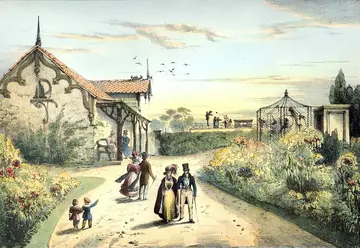
Earliest Zoo structure
The earliest surviving animal cage to be built at London Zoo, the Ravens’ Cage is preserved as a monument to our history.
Designed by London Zoo’s original architect, Decimus Burton, this ornate ironwork aviary dates back to the earliest days of ZSL. In 1828, the Zoo first opened to members of ZSL and their guests, and the aviary was probably completed around 1829.

In an early lithograph of the Zoo by James Hakewill, dating from the 1830s, it is pictured close to the original Llama House (now the Clock Tower). Initially built as summer accommodation for the Zoo’s macaws, the octagonal aviary was also used to house vultures, ravens and possibly owls over the years.
The Ravens’ Cage has been relocated and renovated over the years. Like other Zoo buildings, it was damaged during the German bombings of London in World War II, and it was rebuilt in 1948. At some point in its history, wire mesh replaced the original bars. In 1971, the Ravens’ Cage was moved to its current location and a brick plinth was added to the base of the structure. It has previously been used as a feeding station for the Zoo’s resident wild birds.
A giant in our history
Jumbo the elephant
The remarkable life story of Jumbo the elephant - the animal superstar who is said to have inspired the movie Dumbo.
The Ravens’ Cage now…
Although the Ravens’ Cage has been extensively rebuilt and restored over the years, it still retains the same general appearance as it did in the Zoo’s early days, and it can still be found not far from the Clock Tower.
Today we no longer consider the Ravens’ Cage suitable for birds, and it is no longer in use. It remains as a Grade II-listed landmark from Zoo history, and a reminder of how zoological design has evolved as our scientific understanding of animal care has grown.
Although you’ll no longer find ravens in the animal collections at London Zoo, we still maintain a connection with these striking and intelligent birds. Our veterinary team carries out regular health checks on the famous royal ravens kept at the Tower of London. Legend has it that if the ravens ever left the tower, the kingdom would fall!
